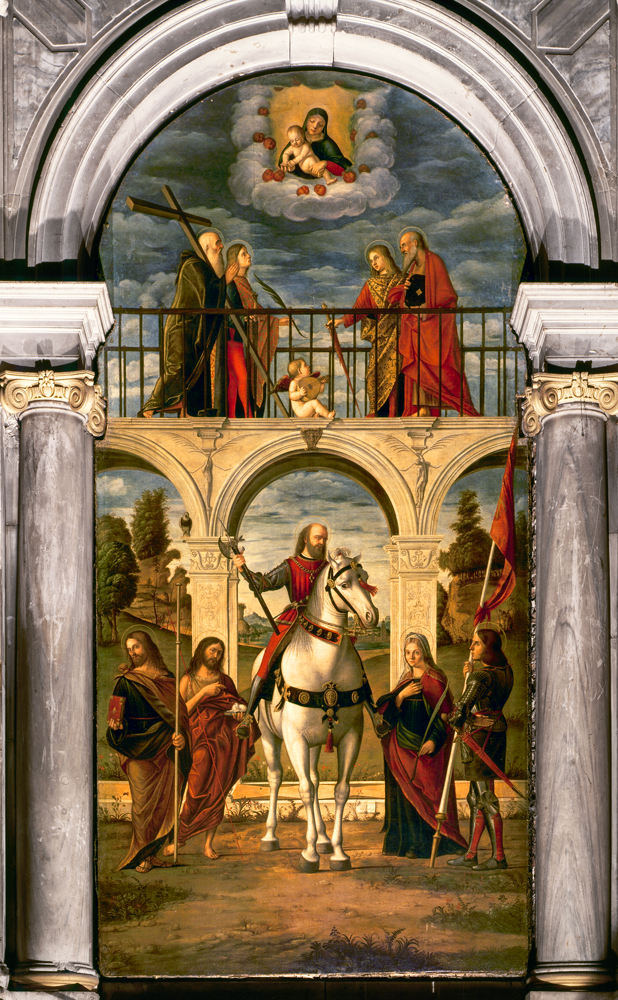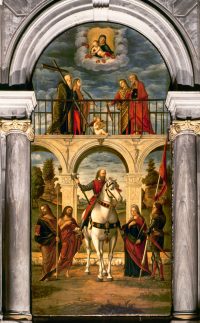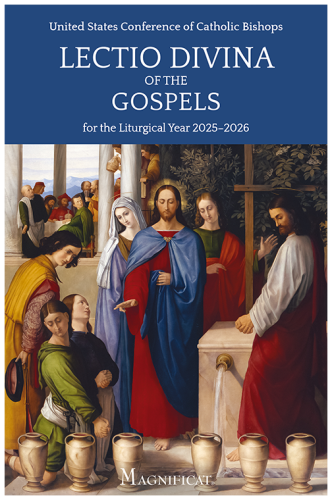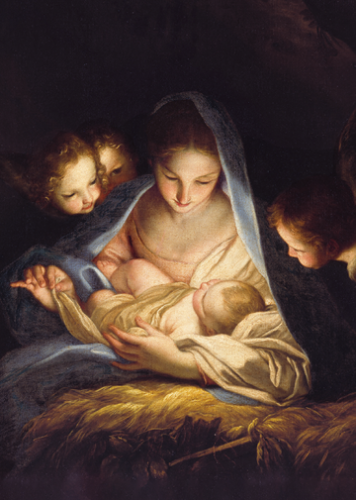The Glory of Saint Vitalis (1512),
Vittore Carpaccio (c. 1460–c. 1526).
When considering Catholic art, one may be tempted to only think of the best-known works by the greatest artists, celebrating the best-known saints. Bernini’s Saint Teresa in Ecstasy, Caravaggio’s Doubting Thomas, or a Madonna and Child by Raphael may come to mind. While this is understandable, it means that we often overlook many other artworks by less famous artists, depicting forgotten saints and martyrs. At the start of the month of November, the Church celebrates the Solemnity of All Saints. On this day, Christians rejoice in the glory of the whole heavenly host, of those saints who are well known and those who have passed into near-legend. Early Church martyrs, whom we know little about, are often depicted in painting, and often have a local devotion that can remain to the present day. One such painting is The Glory of Saint Vitalis by Vittore Carpaccio.
Vittore Carpaccio was born in the 1460s in Venice and studied painting under Gentile Bellini. His work is often characterized by the use of perspective, with a keen attention to architectural detail. He painted many large altarpieces for churches in Venice, among them The Glory of Saint Vitalis painted for the church of Saint Vitalis in 1514.
Saint Vitalis
Not much is known about the painting’s subject. He seems to have been a wealthy resident of Milan during the 1st or 2nd century. A soldier assigned to accompany the judge Paulinus, he was tortured on the rack and then buried alive when Paulinus discovered that he was a Christian. He died in Ravenna, and he remains the principal patron of that city to this day.
In Carpaccio’s altarpiece, we see the saint sitting on a horse squarely in the lower center, holding a soldier’s axe, symbolizing his martial position during life. He is accompanied by a host of figures arranged in three tiers. On the top tier, in the sky, we see the Blessed Mother and the Child Jesus seated in heaven, looking down favorably on Vitalis, as well as the others, and surrounded by putti, who are painted in red to signify their rank as seraphim.
On the second tier, four saints—all of whom are likewise martyrs—stand on an arched bridge, gazing up at the Madonna. This group is separated from the foreground and background by Carpaccio’s typical use of detailed architecture, slicing across the composition. On the left, Saint Andrew holds the cross of Christ, while Saint Peter stands on the far right. Saints Gervaise and Protasius, Vitalis’ sons, hold a palm leaf and a bloodied sword.
On the lowest tier we see the saint himself. On the right, Vitalis’ wife, Saint Valeria, holds another palm leaf, and Saint George a banner. On the left, Saint James is joined by Saint John the Baptist. Throughout the painting, the color red, in all its “earthy” hues, dominates and emphasizes the theme of martyrdom, or the shedding of blood.
The glory of the martyrs
Yet Vitalis himself, framed by the center arch of the bridge, does not himself hold a symbol of martyrdom. Instead he raises his right arm, holding his weapon triumphantly. Why did Carpaccio depict him like this? Shouldn’t he too be somber, clearly showing us the means by which he died? As the title of the work, The Glory of Saint Vitalis, suggests, he is depicted not in his death agony but as a triumphant hero. The soldier holding the banner reinforces this triumphalism. It is an illustration of the glory that is given to the martyrs. The artist shows that by participating in Christ’s own death, the martyrs experience a new beginning, a new creation.
In addition to reinforcing the theme of martyrdom, the various figures and “props” serve to direct the visual movement across the canvas. In order to break up the monotony of the horizontal lines created by the three-tiered structure, Carpaccio creates a web of diagonal movements, using the objects held by all the figures. The most prominent diagonal comes from the cross at the top left, down past Saint Vitalis’ and his horse’s head, ending in the sheathed sword of the soldier in the lower right. It is offset by the movement of the banner leaning toward the right. The palm leaves, swords, and so forth either echo or contrast these movements.
Standing firm with Christ
Saint James, by contrast, holds a pole, perfectly still and vertical. This helps to visually stabilize the diagonal movements, but also represents a theological truth: In the web of spiritual struggle, the saints remain firm and stable. They stand firm on Christ, the spiritual bedrock and source of life for all the martyrs and saints, as well as those of us still struggling on our own spiritual journey. In this way, Carpaccio implies the presence of the whole host of heaven with whom Saint Vitalis is numbered.
Christopher Alles
Artist based in New York State who specializes in sacred art.
The Glory of Saint Vitalis (1512), Vittore Carpaccio (c. 1460–c. 1526), San Vidal, Venice, Italy. © Cameraphoto Arte Venezia / Bridgeman Images.













Additional art commentaries